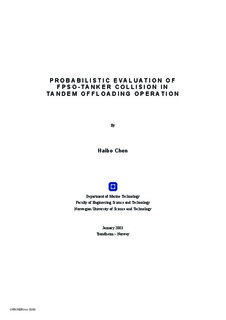| dc.description.abstract | Collisions between FPSO and shuttle tanker in tandem offloading operation have caused a growing concern in the North Sea. Several recent contact incidents between FPSO/FSU and shuttle tanker have clearly demonstrated a high likelihood of contact between vessels in tandem offloading. The large masses involved, i.e. the high potential impact energy, make the collision risk large. Traditional ship/platform collision frequency modeling may not be applicable in the tandem offloading context. Moreover, offshore quantitative risk analyses generally focus more on technical aspects, little on human and organizational aspects. This leads to a hardware-dominated risk reduction approach, and it has been proved not to be effective to mitigate risks involved in complex marine operations in general.
Frequency modeling of collision between FPSO and shuttle tanker in offloading operation is carried out in this study. The collision frequency model is structured in two stages, i.e. the initiating stage and the recovery stage, where the former involves an uncontrolled forward movement of tanker, and the latter involves the recovery actions initiated from tanker and FPSO to avoid the collision.
In the initiating stage, this study focuses on tanker drive-off forward scenarios. Macroscopically, the frequency of tanker drive-off ahead during offshore loading and specifically during tandem offloading is portrayed by statistical data from an earlier study, recent SYNERGI incident data, and expert judgments made by tanker DP operators. Relatively high frequency values of tanker drive-off in tandem offloading are found. Microscopically, the tanker drive-off ahead scenario is investigated by examining 9 such events in tandem offloading based on investigation reports, interviews and discussions with individuals who directly or indirectly were involved. Findings reveal that in order to effectively reduce tanker drive-off in tandem offloading, efforts should be targeted on minimizing those failure prone situations, i.e. the excessive relative motions (termed as surging and yawing) between FPSO and tanker. A simulation-based study is carried out to quantitatively assess and effectively minimize the occurrence of excessive surging and yawing events. Horizontal motions of FPSO and tanker in tandem configuration are simulated via a state-of-the-art time-domain simulation code SIMO. Findings demonstrate that excessive surging and yawing events can be effectively minimized via measures such as minimizing FPSO surge and yaw motions in offloading, coordinating mean heading between FPSO and tanker, and using the dedicated DP software with the tandem loading function on tanker. Ultimately, these measures may provide a sound operational environment where the possibility of tanker drive-off can be minimized.
In the recovery stage, this study is focused on the recovery action initiated by the tanker DP operator. Possible recovery actions are identified and evaluated. Based on calibrated tanker motion simulations, the allowable time for DP operator to initiate recovery action, so that tanker can be stopped within a separation distance, e.g. 80 m to FPSO, is found to be critically short. A 3-stage information-decision-execution model is generalized to model the DP operator’s information processing stages regarding action initiation when in a drive-off scenario. Based on this human information-processing model, expert judgment by simulator trainer and questionnaire survey among shuttle tanker captains and DP officers are conducted, reasonable estimates of the time needed for action initiation are obtained. The estimates are found to be convergent to the facts in the incidents. Findings suggest that tanker DP operators in general need more time to initiate recovery action than the allowable time window, i.e. recovery failure is likely due to lack of reaction time. Two principal recommendations are proposed to reduce the recovery failure probability, i.e. to provide a longer time window for the operator to initiate recovery action, and/or to provide various kinds of assistance to the operator to reduce the recovery action initiation time.
To increase the time window, a promising measure is to substantially increase the separation distance between FPSO and tanker, e.g. from 80 m to 150 m. The feasibility of this measure is discussed from a number of perspectives. Recovery improvement gains are assessed. The key question concerning implementation is to know how much separation distance should be configured in the operation. This has to be based on considerations of both human operators’ need for reaction time, and tanker drive-off behavior. Parametric tanker drive-off motion simulations are carried out in which human action at various times are imposed. The necessary distance values to stop the tanker are then obtained, and ideally these should correspond to the separation distance values between FPSO and tanker in tandem offloading. These findings provide decision-making support to select an optimum field configuration for FPSO-tanker tandem offloading, which may inherently minimize the collision risk.
Effective reduction of reaction time can be achieved by early detection and/or quick decision-making. This is based on the operator information-processing model generalized earlier in this study. Measures to improve early detection are identified. Discussions are guided by the human signal detection theory, and supported by the operational facts of alarm and non-alarm signals in the operation. Measures to effectively reduce the operator’s time involved in diagnosis and situation awareness are also identified. They are theoretically built on the generic human decision-making theory, and specifically designed for drive-off intervention based on the facts collected via a questionnaire survey among shuttle tanker captains and DP officers. These findings illuminate a broad area in the human factor perspective, i.e. training, procedure, crew resource management, human-machine interface, and automation support, where measures to reduce operator reaction time should be targeted. These measures may directly reduce the FPSO-tanker collision risk in tandem offloading. | nb_NO |
